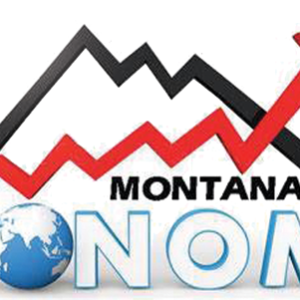Despite a high-performing job market, economic growth in Montana slowed in 2024, continuing a three year decline following the pandemic year boom of 2022, when the state had one of the fastest growing economies in the US, according to Jeffrey Michael, the new director of the Bureau of Business & Economic Research during its annual Economic Outlook Seminar. It looks like growth for 2024 is going to come in at about 2.4 percent of non-farm earnings – better than what was predicted.
In 2023, Montana fell back to a level closer to its historic average, and is likely to maintain that average in 2025 with a projected growth rate of 1.7 to 1.8 percent, which Michael said may be a bit too pessimistic.
Even though there has been much talk about Montana’s population growth spurt, the reality is, in 2024, Montana’s population growth fell to its lowest level in decades. At the same time, Montana’s traditional resource-based industries of agriculture, mining, and forest products, all experienced downturns in 2024.
Other projections for Montana is that the population growth will slow even further; the full impact of mining and wood products closures and their layoffs are likely to be further felt in 2025; and interest rate sectors will get little relief.
Inflation is down but it hasn’t been defeated. Because of that the Federal Reserve has indicated it is going to pause in reducing interest rates in 2025.
The good news will come after 2025, according to Michael. It’s then that moderate population growth will resume; the state’s tech industry will continue to mature; and new investments are likely in mining, energy and tourism.
Michael said that Montana’s population grew slower than that of the US for the first time since 2012. At 0.5 percent population growth in 2024 was the lowest in two decades. The decline happened for several reasons. Net migration into Montana from other states dropped to 5,400 in 2024 from a peak of 20,500 in 2021. Also, according to Michael, Montana has not felt the surge in international in-migration (legal and illegal) that has powered recent population growth in other states. Montana ranks last in international migration and is the only state with fewer than a thousand international migrants in 2024. However, births exceeded deaths last year, which was the first time that natural population increased in several years.
Even though population growth has slowed, the impacts of the earlier rapid growth are still being felt throughout the state. Most notably are persistent high housing costs. In fact, Montana’s population growth will likely remain slow until housing prices and income become more balanced, which may take years.
While the future is highly uncertain in 2025, Montana is likely to maintain slow to moderate growth because Montana is less dependent on international trade and immigration than other states and will likely be less affected by growing global uncertainty and changes in federal policies.
The seminar highlighted the emerging technology of AI (Artificial Intelligence). In introducing the subject, Pat Barkey said they wanted to focus on AI, because of its potential to benefit Montana businesses. Pat Barkey will retire in June as BBER’s director, a position he has held for 17 years.
AI has the capability to enhance productivity and it could enhance almost every industry, said Michael. “You could see significant productivity gains in the future.”
While aspects of AI have been coming at us for several years, its advances were little noticed until it gained the ability to write text, compose music and create art, said Barkey, adding “The speed of its development has been torrid.”
A question that is often asked is “will AI take over my job?” And the conference answer to that was, “No, but someone who understands AI will.”
Barkey said the question that many are asking: Is this going to be like the Industrial Revolution in bringing the entire economy to a different level of growth?
“It’s been a fast moving phenomena,” said Barkey, “What it is really good at is dealing with piles and piles and piles of unconstructed data.” It holds the promise of being able to increase the growth in productivity, which is significant, said Barkey, because “growth and productivity in the economy is what fuels our standard of living.”
We learned a “heck of a lot about production” in World War II, said Barkey. “We put those lessons to use in the following decades. Coming out of the 50s and 60s, we had relatively high average growth.”
Since then there has been some fluctuation in the 80s and 2000s because of the internet and computers.
According to Barkey, “There has been no game change in the technological development in the economy since World War II. . . nothing like the industrial revolution ‘that changes everything’. . . Nothing has moved the needle to the entire economy to take productivity to a new level. AI might not be that but it sure looks like it has a lot of promise. . . It doesn’t take much to make a really meaningful change in the economic standard of living .. . The economy averages about 2.5 percent since WWII. If we moved it up 3 percentage points out to the year 2040, then we would have almost 50 percent more economic output in the economy than we would have without that extra growth. A little change across the entire economy in the largest economy in the world, gets a whole lot done.”
Personal income growth slowed to 1.2 percent in Montana during 2024, about half of the 2.3 percent growth in 2023, and much slower than the more than 6 percent growth experienced during 2020 and 2021. 2024 was the first year since the Covid upheaval that Montana income grew slower than the US.
Earnings growth in 2024 in construction and the service sectors outperformed resource-based industries over one-year and five-year periods. Construction lead all industries in real earnings growth at $272 million, followed by health care and retail trade with both experiencing over $100 million in earnings growth in 2024.
Montana’s resource-based industries experienced a very difficult 2024. Farm earnings – extremely volatile – show a very sharp decline, after strong earnings in 2022. Mining earnings also declined by about $190 million in 2024, and the full effects of the Sibanye-Stillwater mine closure may not be fully captured in the data. Forestry activities experienced a $19 million earnings’ decline and wood products mill closures are a factor behind an $18 million decline in manufacturing earnings.
So what is sustaining job growth in Montana?
Jobs are less affected by the declines in commodity prices and real estate sales that have pulled down incomes. Montana’s job growth was 1.5 percent in 2024, strong enough to rank in the top five states, but only half the 3 percent job growth seen in 2023. Jobs grew fastest in construction and services, with declines in mining, finance and real estate.
Said Michael, “The US economy has seen a much more dynamic labor force and a more dynamic business center in the past couple of years more than we have seen in the past decade or two.”
People ask why the US economy does so much better than Europe and other countries, according to Michael, who explained, “Labor market researchers found that the US worker is two and a half times more likely to change industries and occupations than a worker in Europe. In the US workers are much more willing to change or move to a new sector that is more productive or where labor is more needed. We have also seen an increase in entrepreneurship, individuals who are willing to take a risk and start a business — all of which is beneficial for the economy. And the last thing is the population growth. It is a controversial topic, but there is no doubt that it is a contributor. . . US population growth was more than we anticipated and more people means more workers and more demand in the economy.”
During the 2010s, continued Michael, people were scratching their heads and asking what happened to the American entrepreneur in the 2010s? “The rate of business start- ups was a mystery.” Since 2020 the level of entrepreneurial business creation has increased and sustained at higher levels. “


